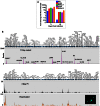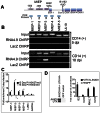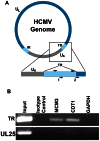Cis and trans acting factors involved in human cytomegalovirus experimental and natural latent infection of CD14 (+) monocytes and CD34 (+) cells
- PMID: 23717203
- PMCID: PMC3662700
- DOI: 10.1371/journal.ppat.1003366
Cis and trans acting factors involved in human cytomegalovirus experimental and natural latent infection of CD14 (+) monocytes and CD34 (+) cells
Abstract
The parameters involved in human cytomegalovirus (HCMV) latent infection in CD14 (+) and CD34 (+) cells remain poorly identified. Using next generation sequencing we deduced the transcriptome of HCMV latently infected CD14 (+) and CD34 (+) cells in experimental as well as natural latency settings. The gene expression profile from natural infection in HCMV seropositive donors closely matched experimental latency models, and included two long non-coding RNAs (lncRNAs), RNA4.9 and RNA2.7 as well as the mRNAs encoding replication factors UL84 and UL44. Chromatin immunoprecipitation assays on experimentally infected CD14 (+) monocytes followed by next generation sequencing (ChIP-Seq) were employed to demonstrate both UL84 and UL44 proteins interacted with the latent viral genome and overlapped at 5 of the 8 loci identified. RNA4.9 interacts with components of the polycomb repression complex (PRC) as well as with the MIE promoter region where the enrichment of the repressive H3K27me3 mark suggests that this lncRNA represses transcription. Formaldehyde Assisted Isolation of Regulatory Elements (FAIRE), which identifies nucleosome-depleted viral DNA, was used to confirm that latent mRNAs were associated with actively transcribed, FAIRE analysis also showed that the terminal repeat (TR) region of the latent viral genome is depleted of nucleosomes suggesting that this region may contain an element mediating viral genome maintenance. ChIP assays show that the viral TR region interacts with factors associated with the pre replication complex and a plasmid subclone containing the HCMV TR element persisted in latently infected CD14 (+) monocytes, strongly suggesting that the TR region mediates viral chromosome maintenance.
Conflict of interest statement
The authors have declared that no competing interests exist.
Figures










References
-
- Landolfo S, Gariglio M, Gribaudo G, Lembo D (2003) The human cytomegalovirus. Pharmacol Ther 98: 269–297. - PubMed
-
- Mocarski ESaC, T. C. (2001) Cytomegaloviruses and Their Replication. In: Knipe DMaH, P. M., editor. Virology. 4 ed. Philadelphia: Lippincott Williams & Wilkins. pp. 2629–2674.
-
- Pari GS (2008) Nuts and bolts of human cytomegalovirus lytic DNA replication. Curr Top Microbiol Immunol 325: 153–166. - PubMed
Publication types
MeSH terms
Substances
LinkOut - more resources
Full Text Sources
Other Literature Sources
Medical
Research Materials

